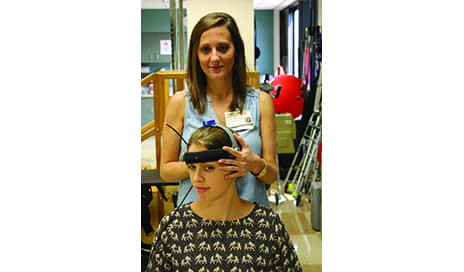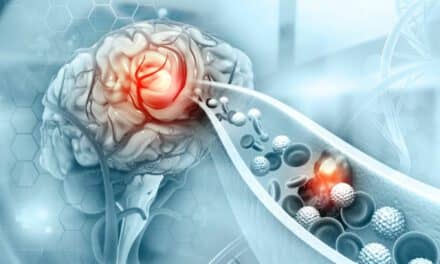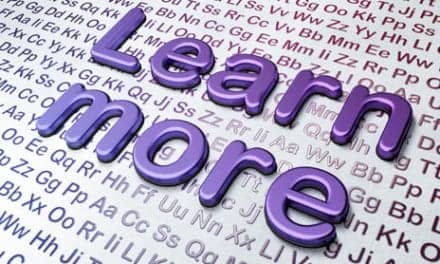By Holly Cauthen, PT, DPT, and Kelsey Hatton, AuD, CCC-A
Although some “gold standard” vestibular testing and treatments have remained relatively unchanged over time, there are many technologies at the therapist’s disposal to help patients with vestibular impairment. This article aims to review new and possibly unfamiliar technology utilized in a multidisciplinary vestibular clinic and report their applications and efficacy.
We believe that when possible, collaboration between audiology and physical therapy for diagnostic and rehabilitative services provides the most benefit for the vestibular patient population. Diagnostic testing leads to tailoring of therapy based on an individual’s deficits, and repeated testing can monitor specific vestibular functions post physical therapy intervention. Multidisciplinary collaboration is important not only for monitoring patient progress with evidence-based intervention but also for advances in research.
Treatment Technology
The newest innovation in PT technology is a state-of-the-art mechanical rotating chair that will likely become the “gold standard” for advanced analysis, diagnosis, and treatment of semi-circular canal-induced dizziness (ie, BPPV). The TRV Chair allows 360-degree rotational movement in the exact plane of each semicircular canal. The patient can be held in any position during examination. Observation of positional nystagmus is provided during testing via infrared goggles with recording capacity and large wall-mounted display.1 The Epley Omniax System is a repositioning chair built to provide these functions and is available from Vesticon, Portland, Ore.
Current positional testing protocols are variable as each clinician performs each test with varying intensity and speed. Positional testing is often difficult for patients secondary to limited cervical range of motion and pre-existing back discomfort. With the TRV Chair, the patient remains in a seated position, lowering tension traditionally placed on the back and neck. The TRV Chair increases the quality of the diagnosis, simplifies treatment, and is particularly useful those unable to be traditionally positioned. Rehabilitation of patients with BPPV still includes maneuvers such as Epley, Semont, Gufoni, and Appiani. The effectiveness of these maneuvers can be enhanced by adding kinetic energy by driving the main arm of the chair against a hydraulic stop; sufficient to free even the smallest otoconia.2
Minimal research is available in American-based journals, however, a study performed in China found that the TRV Chair significantly improved treatment efficacy and significantly decreased the number of treatment sessions needed for successful repositioning when compared to traditional Canalith Repositioning Procedure (CRP).3
Video Goggles
Infrared video goggles are used to view and video record nystagmus during oculomotor, positional, and caloric testing. The benefits to using infrared goggles include the ability to remove visual fixation, enhance observation of nystagmus on a large screen, and allow video recording for review, education, and scientific/legal purposes. Spending anywhere from $3,000 to $5,000 on video goggles for these features is well worth the investment. A study published in 2012 found that video goggles have a sensitivity of 85% and a specificity of 65% when detecting peripheral vestibular nystagmus. Frenzel glasses were found to be ineffective at the same task, with a sensitivity of 10%.4
Micromedical Technologies Inc, Chatham, Ill, offers several models of video goggles appropriate for physical therapy clinics, including the RealEyes xDVR Binocular Video Goggles, which can be used during the Dix-Hallpike test for diagnosis of BPPV. RealEyes xDVR video goggles can also be used during canalith repositioning to treat BPPV. Likewise, these goggles can enable an examiner to observe subtle differences between right- and left-eye responses, depending on which canal is being tested. Micromedical also offers the RealEyes Monocular xDVR video goggles as a tool for observing eye movement and recording during BPPV therapy or canalith repositioning maneuvers. Both models allow patient eye movement videos to be recorded and displayed into the therapist’s personal computer.
[sidebar float=”right” width = “250”]Product Resources
The following companies offer technologies for vestibular rehabilitation and treatment of dizziness:
Biodex Medical Systems
www.biodex.com
Hoggan Scientific LLC
www.hogganhealth.net
Micromedical Technologies Inc
www.micromedical.com
Natus Medical Inc (NeuroCom)
www.onbalance.com
novel electronics
www.novelusa.com
Perry Dynamics Inc
www.perrydynamics.com
Vesticon
[/sidebar]
Rotational Chair Testing
Rotational chair testing utilizes video goggles to evaluate the function of both horizontal semicircular canals. Most clinics utilize Sinusoidal Harmonic Acceleration (SHA) or Step testing protocols to gauge horizontal canal Vestibular Ocular Reflex (VOR) performance. Both tests evaluate whether gain of eye movements is symmetrical and appropriate, and whether eye movements are coordinated accurately relative to head movements. The benefit of this test is that integration of information from both sides is required for appropriate responses. Improved integration of information or compensation enhanced by therapeutic intervention is measurable with this test by comparing pre- and post-therapy results. A line of rotational chairs is available from Micromedical, including the System 2000 Auto-Traverse Rotational Vestibular chair, which can shift the center of rotation off-axis and perform a dynamic subjective visual vertical test. The company also offers the System 2000 Comprehensive Rotational Chair, which features an XY laser projector for testing in horizontal and vertical directions. The company’s system 2000 Reclining Rotational Vestibular Chair is a standard vertical axis rotational chair combined with a VNG chair that can recline into a caloric incline position as well as a supine position.
Head Impulse Testing
Another video goggle system is the Video Head Impulse Test (vHIT). These devices have been FDA approved since 2013. The test itself is very similar to head thrust testing, but has the added benefit of high-speed cameras capturing eye movements before, during, and after a head thrust is applied. This enables evaluation of gain and timing of the VOR for quick head speeds typically used in daily activities. vHIT also allows the clinician to deliver head impulses to stimulate each of the six semicircular canals.5 Response gain, presence of abnormal saccades, and location of abnormal saccades can be analyzed with this system.
Video Head Impulse Testing is valuable because it is unique in isolating responses from individual vertical canals, it can reveal eye movements during quick head movements, and it allows evaluation of saccade strategies. Patients with reduced VOR gain during fast head movements often employ saccades during or immediately following head impulses. This is thought to illustrate reorganization in central processing, reflecting compensation with saccades which substitute for a loss in VOR gain.6 The appearance and reorganization of saccadic strategies has been shown in patients with surgically induced unilateral vestibular impairments.7
The SMART EquiTest System from Natus Medical Inc, Pleasanton, Calif, is the “gold standard” in balance assessment with Computerized Dynamic Posturography (CDP). The CDP identifies and quantifies both sensory and motor functions involved in balance control. The Sensory Organizational Test protocol assesses the patient’s ability to integrate vestibular, visual, and somatosensory cues in order to maintain balance. The Motor Control Test protocol assesses postural response to sudden forward and back translations of a force plate. The Adaptation Test protocol measures the patient’s ability to respond to sudden stimuli when the force plate is tilted either up or down at the same amplitude. This system is crucial in effectively guiding a treatment plan of care. Advantages of the system have been proven with a 30-year record of clinical use supported by peer-reviewed research.8
Virtual Reality
Virtual reality, as a treatment for vestibular disorders, was first attempted by Viirre and Kramer et al.9 Since that time, vestibular rehabilitation has attempted to recreate disturbing visual stimuli via systems such as WII Balance, disco ball, and optokinetic exercises delivered via DVD or YouTube video. The advent of Google Cardboard from Google in 2014 allowed users to employ a smartphone held by a cardboard “viewer” as an inexpensive way to experience 3D activities, such as riding a roller coaster and scuba diving in the Galapagos Islands. The Samsung Gear VR, powered by Oculus, is similarly designed with activities like traveling across the galaxy. Both systems are marketed as an entertainment tool to create experiences while immersed in a 3D environment.
Unlike other virtual reality technology on the market, Libra@Home has recently developed an application with vestibular rehabilitation in mind. This particular software allows clinicians to create a list of exercises in clinic with set parameters. The patients utilize a Samsung Gear VR and phone application to become immersed in a 3D environment specifically created for optimal outcomes for dizzy patients. The patient will use the equipment in the home for increased frequency and exposure to the individualized program. This allows for individualized therapy which can be provided with protocol adjustments each week, tailored to each patient’s need.
Big Picture Planning
Access to equipment cited in this article may be limited by financial or space limitations. When planning equipment purchases, establishing relationships with colleagues that provide complementary diagnostic or rehabilitative services increases access to these technologies, and helps patients. Testing interleaved with therapy helps track a patient’s dynamic vestibular compensation process. Monitoring compensatory status can reinforce the purpose of rehabilitative exercises assigned as homework, especially when patients are not fully compensated or have decompensated compared to previous visits. Finally, counseling can be improved by tying baseline vestibular function into a guide for family expectations and probable patient outcomes.
While we hope this article provides a review of options, we recommend taking the time to research a variety of sources that offer the latest information to help inform any potential purchase. PTP
Holly Cauthen, PT, DPT, received her Doctor of Physical Therapy at the University of South Alabama in 2011. Cauthen completed the competency-based certification in vestibular rehabilitation in 2013 and is a credentialed clinical instructor through the American Physical Therapy Association. She joined the Vanderbilt Bill Wilkerson Center team in 2014.
Kelsey Hatton, AuD, CCC-A, joined the Vanderbilt Bill Wilkerson Center team in 2013 after completing her Doctor of Audiology at Vanderbilt. Her clinical specialties are diagnostic evaluation of adult and pediatric hearing and vestibular function, and cochlear implants. For more information, contact [email protected].
References
1. Richard-Vitton T, Petrak M, Beck DL. The TVR chair: Introductory concepts. Hearing Review. 2013;20(12):52-54.
2. TRV Chair. Interacoustics Web site. http://www.interacoustics.com/resources/brochures-1/trv-brochures/899-trv-chair-brochure/file. Published May 26, 2016. Accessed September 1, 2016.
3. Tan J, Yu D, Feng Y, et al. Comparative study of the efficacy of the canalith reposi-tioning procedure versus the vertigo treatment and rehabilitation chair. Acta Oto-Laryngologica. 2014;134:704-708.
4. West PD, Sheppard ZA, King EV. Comparison of techniques for identification of peripheral vestibular nystagmus. J Laryngol Otol. 2012;126(12):1209-1215. doi: 10.1017/S0022215112002368.
5. MacDougall H, McGarvie L, Halmagyi G, Curthoys I, Weber K. Application of the video head impulse test to detect vertical semicircular canal dysfunction. Otology & Neurotology. 2013;34(6):974-979. doi:10.1097/mao.0b013e31828d676d.
6. MacDougall H, Curthoys I. Plasticity during vestibular compensation: the role of saccades. Frontiers in Neurology. 2012;3. doi:10.3389/fneur.2012.00021.
7. Mantokoudis G, Saber Tehrani A, Wong A, Agrawal Y, Wenzel A, Carey J. Adaptation and compensation of vestibular responses following superior canal dehiscence surgery. Otology & Neurotology. 2016;37(9):1399-1405. doi:10.1097/mao.0000000000001196.
8. SMART EquiTest® (CDP). Natus Web site. http://natus.com/index.cfm?page=products_1&crid=270&contentid=395. Accessed September 1, 2016.
9. Whitney S, Sparto P, Hodges L, Babu S, Furman J, Redfern M. Responses to a virtual reality grocery store in persons with and without vestibular dysfunction. CyberPsychology & Behavior. April 2006;9(2):152-156. doi:10.1089/cpb.2006.9.152.





